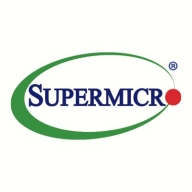![Dell PowerEdge M [EOL] Logo](https://images.peerspot.com/image/upload/c_scale,dpr_3.0,f_auto,q_100,w_64/nb70b5ansummme9cc5q5ymwyalbv.png)

The Supermicro SuperBlade and Dell PowerEdge M [EOL] are two prominent competitors in the blade server market. Supermicro SuperBlade holds an edge in affordability while Dell PowerEdge M [EOL] is favored for its feature-rich performance.
Features: Supermicro SuperBlade offers energy efficiency, high-density computing power, and a focus on cost-effective computing. Dell PowerEdge M [EOL] excels in integration capabilities, robust management tools, and advanced networking features.
Room for Improvement: Supermicro SuperBlade could enhance its integration capabilities, expand its management tools, and improve scalability features. Dell PowerEdge M [EOL] may benefit from reducing setup complexity, optimizing energy efficiency further, and improving initial cost-effectiveness.
Ease of Deployment and Customer Service: Supermicro SuperBlade is known for a straightforward deployment process and responsive support. Dell PowerEdge M [EOL] provides extensive support options and seamless system integration, offering a broader deployment framework.
Pricing and ROI: Supermicro SuperBlade presents attractive initial costs with a quick return on investment. Dell PowerEdge M [EOL], while having higher initial costs, offers a strong long-term ROI owing to its durability and advanced capabilities.
| Product | Market Share (%) |
|---|---|
| Dell PowerEdge M | 16.9% |
| Supermicro SuperBlade | 7.1% |
| Other | 76.0% |


| Company Size | Count |
|---|---|
| Small Business | 12 |
| Midsize Enterprise | 3 |
| Large Enterprise | 10 |
Dell PowerEdge M is known for maximizing efficiency with high core and RAM density, supporting virtual environments and ensuring reliable performance and impressive scalability.
Known for its cost-effectiveness, Dell PowerEdge M offers robust performance and extensive management features like iDRAC and OpenManage for centralized monitoring. It provides strong security capabilities and flexible interface options. Key areas for improvement include boot time delays from POST checks and challenges with iDRAC instance, needing better networking and connectivity options including AMD CPUs and Ethernet enhancements. Users highlight the need for improved scalability, VLAN configurations, and caching. Dell PowerEdge M primarily supports applications like server virtualization and data center consolidation, operating effectively in cluster environments like solar power plant data logging.
What are the key features of Dell PowerEdge M?Dell PowerEdge M finds its implementation in critical applications such as server virtualization and compute, addressing wide-ranging workloads from administrative tasks to scientific computing. Organizations leverage its capabilities in virtual machine hosting, hyper-converged infrastructure management, and balanced load handling, enhancing its effectiveness in environments like solar power plant data logging.
Supermicro SuperBlade delivers innovative computing performance and efficiency, perfect for data-intensive tasks. With its modular design, it optimizes space and power, providing a flexible and scalable infrastructure for demanding business workloads.
Supermicro SuperBlade is specifically engineered for modern data centers needing high-density computing. It offers a compact, modular architecture that simplifies system management and enhances agility. It integrates seamlessly with cloud and virtualization technologies, supporting diverse applications and workloads. Its design focuses on reducing operational costs while achieving peak performance. Users appreciate its balance of power efficiency and high computing capacity.
What are the key features of Supermicro SuperBlade?Supermicro SuperBlade is widely implemented in sectors such as finance, healthcare, and research where high computational power and storage are critical. In finance, it's used for real-time analytics and transactions. Healthcare facilities use it for patient data analysis and complex simulations, while research institutions leverage SuperBlade for simulations and data-intensive research tasks. Its adaptability allows enterprises to efficiently meet technical requirements unique to each industry.
We monitor all Blade Servers reviews to prevent fraudulent reviews and keep review quality high. We do not post reviews by company employees or direct competitors. We validate each review for authenticity via cross-reference with LinkedIn, and personal follow-up with the reviewer when necessary.